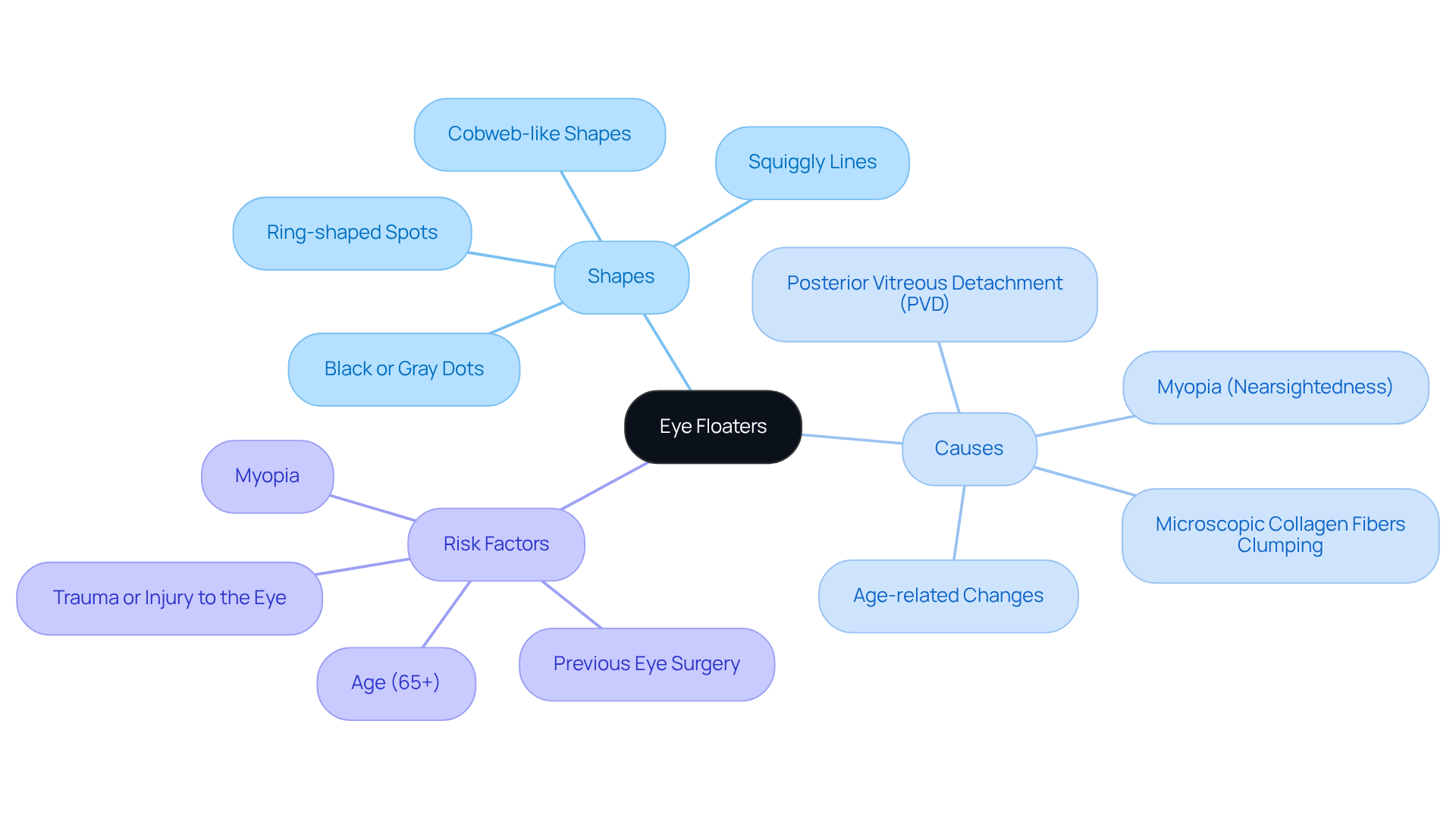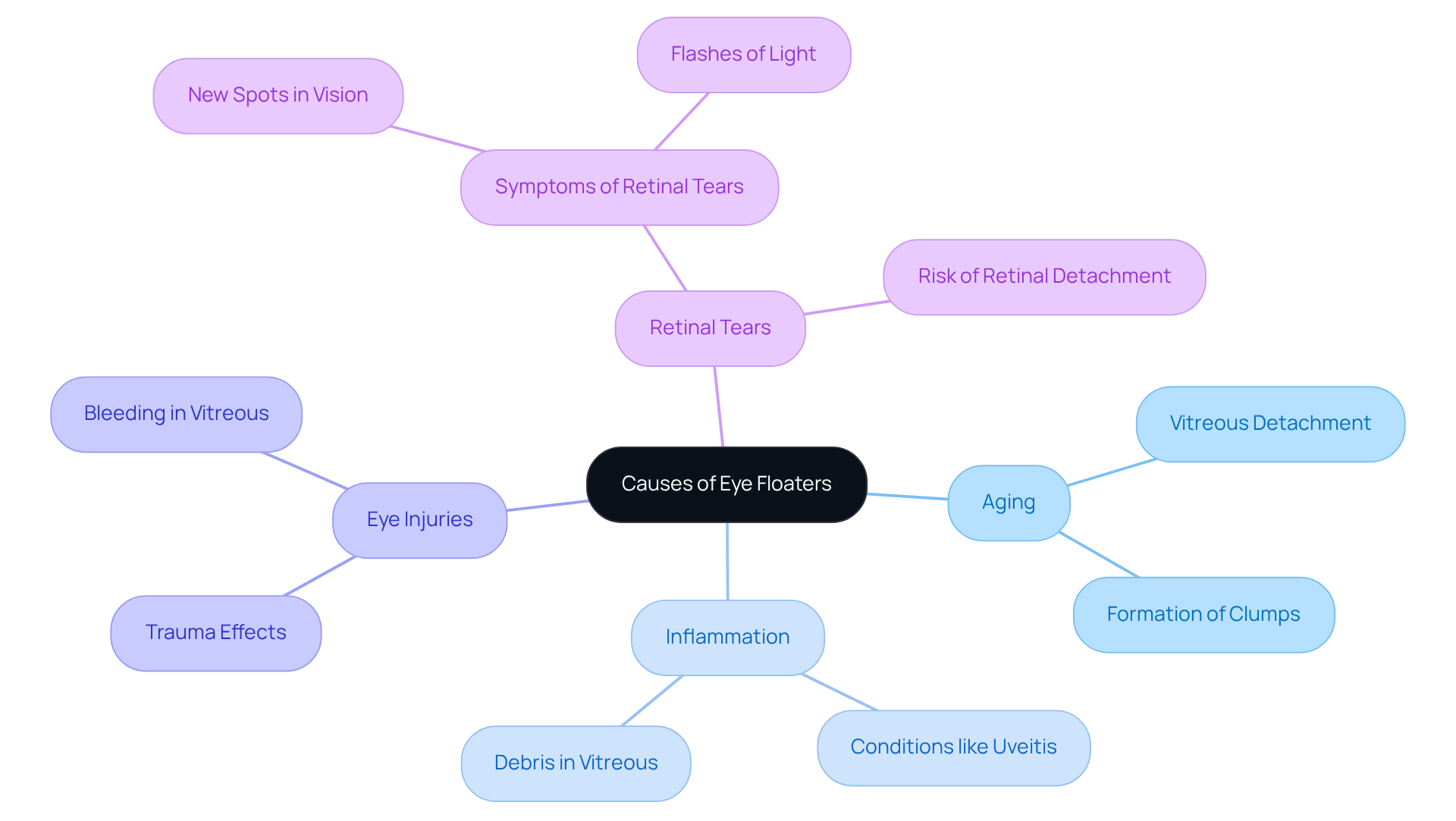Posted by: Northwest Eye in General on June 28, 2025
Overview
Eye floaters are small shapes that can appear in your field of vision. They are commonly caused by microscopic collagen fibers clumping together in the vitreous humor, and their occurrence tends to increase with age. We understand that noticing these floaters can be concerning.
It’s important to recognize certain symptoms, such as a sudden increase in floaters or flashes of light. These may indicate serious conditions, like retinal tears, that warrant immediate medical attention. We want to reassure you that seeking care promptly can help prevent potential vision loss.
Remember, you are not alone in this experience, and we are here to help you through this process. If you notice any alarming changes in your vision, please do not hesitate to reach out for support.
Introduction
Understanding the nuances of eye floaters is essential for anyone experiencing these visual disturbances. We understand that noticing tiny specks or cobwebs drifting in your field of vision can be both perplexing and alarming, especially when they become more noticeable against bright backgrounds. This article delves into the causes and symptoms of floaters, as well as the critical moments when seeking medical attention becomes imperative.
Our goal is to provide you with the knowledge to differentiate between harmless floaters and signs of serious eye conditions. It’s common to feel uncertain when faced with sudden changes in vision, but early intervention can make a significant difference in your eye health.
Define Eye Floaters: Characteristics and Types
Eye specks are small shapes that can appear in your field of vision, often described as spots, threads, or cobwebs. We understand that noticing these can be concerning, especially when they become more prominent against a bright background, like a clear sky or a white wall. Floaters can vary in shape and size, including:
- Black or gray dots: These are the most common type of floaters, appearing as small specks.
- Squiggly lines: Often resembling threads or strands, these spots can move with your eye movements.
- Cobweb-like shapes: These may appear as intricate patterns that drift across your vision.
- Ring-shaped spots: Less common, these can create a circular appearance in your visual field.
Understanding these traits can help you recognize floaters in vision and distinguish them from other potential eye issues. It’s important to know that floaters in vision are primarily caused by microscopic collagen fibers clumping in the vitreous, leading to visual disturbances. Research indicates that the occurrence of floaters in vision increases with age, particularly peaking among individuals aged 65 and above, with studies revealing that around 66.5% of this group experiences floaters in vision.
Additionally, if you have myopia (nearsightedness), you may face a higher risk of experiencing visual disturbances. We emphasize the importance of being aware of these symptoms and seeking prompt assessment by an ophthalmologist if they occur. Remember, vitreous opacities can be linked to serious conditions like macular holes or retinal detachments, which require immediate medical attention. We are here to help you through this process and ensure you .

Explore Causes of Eye Floaters: Understanding the Mechanisms
Visual disturbances can be concerning, often arising from changes in the vitreous humor, the gel-like substance that fills your eye. As we age, typically between 50 and 70, the vitreous may liquefy and shrink. This process can lead to the formation of tiny clumps or strands that cast shadows on the retina. When this occurs, it is known as , which happens when the vitreous separates from the retina. Unfortunately, this can often lead to an increase in visual disturbances. It’s important to note that 1 in 6 individuals may experience a retinal tear due to posterior vitreous detachment, highlighting the importance of paying attention to any visual changes you notice.
Other factors can contribute to these disturbances:
- Inflammation: Conditions like uveitis can introduce debris into the vitreous, resulting in floaters.
- Eye injuries: Trauma may cause bleeding or changes in the vitreous, which can result in floaters in vision.
- Retinal tears or detachments: These serious conditions can manifest as new spots in your vision, often accompanied by flashes of light, which may indicate a need for urgent medical evaluation.
Understanding these causes is essential for you to determine whether your visual disturbances are harmless or indicative of a more serious issue. Routine eye examinations play a crucial role in monitoring these disturbances and preventing potential complications, especially if you have risk factors such as a family history of retinal issues or ongoing conditions like diabetes and hypertension. If you suddenly notice new spots or flashes of light, please seek prompt medical attention, as these symptoms could suggest a retinal tear. Remember, visual disturbances can be permanent once they appear, and we are here to help you through this process.

Identify Symptoms of Eye Floaters: Recognizing the Signs
Symptoms of floaters in vision can vary, and we understand that experiencing floaters in vision can be concerning. Common experiences include:
- Seeing spots or specks: These may drift in and out of your field of vision.
- Squiggly lines or threads: Particularly noticeable against bright backgrounds, these can be distracting.
- Cobweb-like shapes: These may seem to drift across your sight, often causing concern.
While floaters are typically harmless, it’s important to recognize symptoms that warrant immediate medical attention:
- Sudden increase in floaters: A rapid onset of new floaters can indicate a serious condition. Studies show that about 30% of individuals experience this at some point.
- Flashes of light: Accompanying flashes may suggest retinal issues, which require prompt evaluation.
- Loss of peripheral sight: This could indicate a retinal tear or detachment, necessitating urgent care.
Being aware of these symptoms is crucial for making informed decisions about seeking medical care. If you notice floaters in vision within your visual field, we encourage you to consult for a professional evaluation. Floaters can occasionally be linked to blurred sight, which may stem from different eye conditions like cataracts or diabetic retinopathy. Routine eye check-ups are vital for observing any alterations in sight, as early action can greatly safeguard your eyesight. Remember, maintaining your routine eye examinations is the optimal method to protect your eyes and ensure a lifetime of good eye health.
Determine When to Seek Help: Recognizing Serious Symptoms
It is essential to seek medical help if you experience any of the following:
- Sudden onset of floaters: We understand that noticing a sudden increase in floaters can be alarming. If this is accompanied by flashes of light, please contact immediately.
- Blurred sight: This symptom can be concerning, as it may indicate .
- Dark shadows or curtains: If you see a shadow obstructing part of your sight, it’s important to know that this may indicate a retinal detachment.
- Pain or redness in the eye: These symptoms can signal inflammation or injury that requires prompt attention.
Recognizing these serious symptoms can truly be life-saving. They may indicate conditions that could lead to permanent vision loss if not treated promptly. Remember, we are here to help you through this process and ensure your well-being.
Conclusion
Understanding eye floaters is crucial for maintaining your eye health, as they can signify both benign changes and serious conditions. We recognize that these visual disturbances can be concerning, and being aware of their characteristics, causes, and symptoms empowers you to make informed decisions regarding your eye care. It’s important to know when to seek medical help, as this awareness can be life-saving, especially in cases of sudden changes in vision that may indicate underlying issues.
In this article, we explored the various types of eye floaters, from common black specks to more intricate cobweb-like shapes. We discussed the mechanisms behind their occurrence, particularly the aging process and other contributing factors such as inflammation or eye injuries. Remember, being vigilant about symptoms that require immediate medical attention—like a sudden increase in floaters or flashes of light—is essential.
Ultimately, prioritizing regular eye examinations and being proactive about any changes in your vision is vital for safeguarding your eye health. By understanding eye floaters and their implications, you can take the necessary steps to ensure your vision remains clear and healthy. Seeking help from an eye specialist when experiencing concerning symptoms not only addresses immediate worries but also fosters long-term eye care. We are here to help you through this process, ensuring you feel supported every step of the way.
Frequently Asked Questions
What are eye floaters?
Eye floaters are small shapes that can appear in your field of vision, often described as spots, threads, or cobwebs.
What do eye floaters look like?
Eye floaters can vary in shape and size, including black or gray dots, squiggly lines resembling threads, cobweb-like shapes, and less commonly, ring-shaped spots.
What causes eye floaters?
Floaters are primarily caused by microscopic collagen fibers clumping in the vitreous, leading to visual disturbances.
Who is more likely to experience eye floaters?
The occurrence of floaters increases with age, particularly peaking among individuals aged 65 and above, with studies showing that around 66.5% of this age group experiences floaters. Additionally, individuals with myopia (nearsightedness) may have a higher risk of experiencing floaters.
When should I seek medical attention for eye floaters?
It is important to seek prompt assessment by an ophthalmologist if you notice floaters, as they can be linked to serious conditions like macular holes or retinal detachments that require immediate medical attention.






